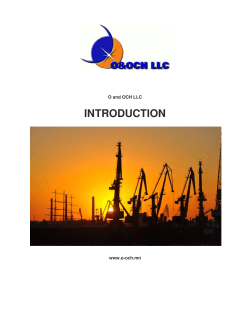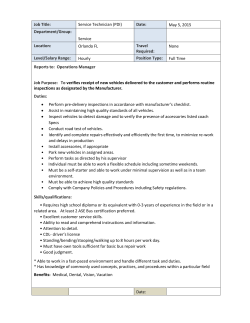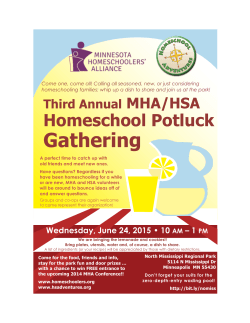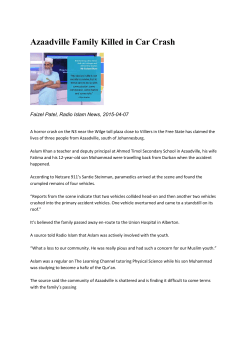
PDF 1.3MB - BeSMART.ie
Construction Tool Box Talk Part 1 of 12 Working on Roads • Suitable Signing, Lighting and Guarding (SLG) must be in place to safeguard workers and members of the public Signing, lighting and guarding must be checked regularly by the CSCS holder and must be cleaned, maintained or replaced as required • Overhead and underground services must be identified and safety arrangements must be put in place (e.g. isolation, diversion of services, no tip zones etc) Safe routes for pedestrians, vehicles and vulnerable road users must be provided around roadworks and the area(s) must be adequately lit • Adequate work space must be provided for the safe operation of plant and equipment, the safe movement of workers and storage of materials • Work area must be clearly marked and must be protected with buffer or safety zones • Site traffic must have safe access • If the works are not completed at the end of the work day then controls must be in place to make sure members of the public, in particular vulnerable road users, are not put at risk e.g. security of site, SLG • Signing, lighting and guarding must be removed when work has been completed • Personal Protective Equipment (e.g. high-visibility clothing, safety helmet, safety boots) must be provided and worn • A traffic management plan must be developed by a competent person and brought to the attention of all workers • • • • All signing, lighting and guarding at roadworks must be put in place, altered or removed under the supervision of a person holding a valid CSCS card When the person holding CSCS Signing, Lighting and Guarding is not on site, someone holding CSCS Assisting in the Implementation of Health and Safety at Roadworks must be on site, and may only make minor alterations to the layout Visit www.hsa.ie or www.BeSMART.ie for more information Construction Tool Box Talk Part 2 of 12 Work at Height • Where it is not possible to use collective protection or to prevent a fall, the distance and/or consequences of a fall must be minimised e.g. by using nets, airbags, fall arrest etc or other suitable equipment/methods Always select the most suitable work equipment for working at height • Provide safe access to work areas at height • Protect all edges and openings to prevent falls • • Persons working at height must be trained and competent Only trained and authorised CSCS scaffolders are allowed to erect, modify or dismantle scaffolding • • Collective protection must be selected where possible i.e. work equipment that protects the largest number of people from falling (scaffolding, guardrails, work platforms etc) and put in place before work starts. Work platforms must have top and intermediate handrails and toeboards fitted • Ladders must only be used for low risk work of short duration and 3 points of contact must be maintained • Equipment used for work at height must be inspected and tested, and records kept • Users of fall arrest equipment must be trained in its inspection and use • Rescue and emergency plans must be in place and training given in same • Injury from falling objects must be prevented e.g. by using toeboards, securing materials stored at height • Avoid work at height wherever possible • Work at height must be planned, supervised and safe • Prepare written risk assessments for all work at height • Visit www.hsa.ie or www.BeSMART.ie for more information Construction Tool Box Talk Part 3 of 12 Electricity on Site • Electrical installations must be installed, repaired and certified as safe by a trained, competent electrician • Check portable equipment, tools and extension reels regularly and take damaged equipment out of use • Electrical installations must be checked regularly and kept in good working order • Where portable equipment is subject to wear and tear it must be inspected and tested regularly • Electrical equipment and fittings must be suitable for construction work • • Circuits supplying socket outlets must be protected by an RCD (Residual Current Device) and it must be tested regularly Repairs to electrical equipment must be carried out by trained, competent electricians • Uncoil extension leads when using high power equipment or when using for long periods of time to prevent overheating • Temporary lighting must be suitable for the location and protected from breakage • A means of cutting off the power supply to equipment must be provided and employees must be made aware of its location • Suitable fire extinguishers must be provided • • Covers must be in place to prevent contact with live electrical parts Portable equipment and tools must only be powered by 110v supply Visit www.hsa.ie or www.BeSMART.ie for more information Construction Tool Box Talk Part 4 of 12 Overhead Electricity Lines • Overhead electricity lines must be identified, and the voltage and safe working distances determined, before work starts • Exclusion zones must be set up, using barriers bunting and warning signs, and maintained along the route of the overhead electricity lines • Where possible, overhead electricity lines must be diverted or the power switched out before work starts • Suitable goalposts, barriers, bunting and signs must be in place and should be inspected weekly and records kept • Work beneath or close to overhead electricity lines must only be undertaken when a safe system of work has been agreed with the ESB • Materials, plant and equipment must not be stored beneath or near the overhead electricity lines • Crossing points for plant and machinery to cross beneath the overhead electricity lines must be set up and maintained • Controls must be in place to ensure delivery drivers entering site are aware of the overhead electricity lines before offloading materials Visit www.hsa.ie or www.BeSMART.ie for more information Construction Tool Box Talk Part 5 of 12 Underground Services • Drawings and information on underground services must be available before work starts (Contact the service/utility providers) • Underground services must be located, marked and brought to the attention of employees before work starts • Employees tasked with locating underground services must be trained and in possession of a CSCS Locating Under-Ground Services card • Wherever possible, services must be isolated (power switched out, gas lines purged) or diverted around before work starts Visit www.hsa.ie or www.BeSMART.ie for more information • A safe system of work (e.g. permit to dig, hand digging) must be used and monitored by a competent person • Trial holes should be dug, using insulated hand tools, to confirm location and depth of underground services • Excavators or power hand tools must not be used close to underground services • Exposed underground services must be protected from damage and supported where necessary • Services must be laid and marked correctly (correct depth, correct pipe/duct, marking tape) and service drawings updated • Emergency plans must be in place to deal with strikes or damage to underground services, including contact numbers for utility provider and area evacuation Construction Tool Box Talk Part 6 of 12 Slips, Trips and Falls • Work areas and access routes must be adequately lit • Clean as you go. Everybody is responsible for keeping their own work area clean • Keep access routes (including stairs, walkways, working platforms) clean and clear of materials and equipment which could cause trip hazards • Site must be kept clean and storage of materials (deliveries, waste) organised to prevent obstructions • Adequate skips and bins must be provided and waste removed from site in a timely manner Visit www.hsa.ie or www.BeSMART.ie for more information • Safe access must be provided to all work areas including those located above and below ground • Remove exposed nails from timber • Cut or cap protruding rebar Construction Tool Box Talk Part 7 of 12 Vehicles on Site • A traffic management plan (including vehicle and pedestrian routes, loading and parking areas) must be in place and brought to the attention of employees • Site vehicles must be fitted with flashing beacons, mirrors, reversing alarms and reversing cameras, as required • Vehicles and pedestrians entering the site must be controlled (using barriers, gates, signs), with only authorised vehicles allowed on site • Vehicle routes around the site must be suitable for plant and vehicles, and must be kept clear of hazards (e.g. excavations, scaffolding) • Where possible, the site entrance must be set back from public roads/footpaths with warning signs on approach, and public road approaches must be kept clean • Avoid reversing e.g. by using a one way system or dedicated turning area • Obey the site speed limit • Do not overtake Vehicles and pedestrians must be kept apart and routes adequately lit and signed • Make sure site vehicles are suitable for the task, not overloaded and all loads are secured • Site vehicles must be maintained and serviced according to the manufacturer’s instructions • Operators of site plant must be trained and competent and must hold the relevant CSCS card where required • No passengers should be carried on site vehicles unless they are specifically designed to do so • Visit www.hsa.ie or www.BeSMART.ie for more information Construction Tool Box Talk Part 8 of 12 Manual Handling Manual handling may be an issue in any task that involves lifting, putting down, pulling, pushing, carrying, or moving a load where the characteristics of the load or the environment may pose a risk. • The characteristics of the load that need to be determined are the size, weight, shape, stability, number of repetitions, bending/twisting, physical effort required, etc • The characteristics of the environment that need to be determined are location, distance, height to be lifted from or to, available space, etc • All tasks that involve manual handling with a risk of injury must be identified and risk assessed Visit www.hsa.ie or www.BeSMART.ie for more information • When carrying out the risk assessment, decide if the load is too heavy or too large, unwieldy or difficult to grasp, unstable or has contents that are likely to shift or is positioned so that it requires twisting or bending of the trunk • All work involving manual handling must be planned, organised and carried out by competent persons • Better ways of working with less manual handling must be identified: By using mechanical handling/lifting equipment and training employees in its use By breaking down loads into smaller/lighter sizes By relocating materials storage to reduce carrying distances • Employees must be consulted about measures to be put in place to avoid or reduce manual handling • Manual handling training specific to the tasks must be provided and employees supervised to make sure they are lifting correctly Construction Tool Box Talk Part 9 of 12 Health Employees must be protected from ill health that could be caused or made worse by construction work activities, such as noise induced hearing loss, vibration white finger, asthma, silicosis, dermatitis, burns, eye injuries, Weil’s disease, hepatitis, tetanus, asbestosis etc. • Exposure to hazardous fumes from welding, gas cutting or solvents and paints, must be minimised by using ventilation and/or suitable respiratory protective equipment • Suitable eye protection must be worn when welding, using a consaw, compressed air, cartridge operated tools, or breakers, and when handling chemicals • Activities that could give rise to ill health must be identified and risk assessed • • Employees must be advised of the possible health risks from exposure to noise, vibration, dusts, fumes, wet cement, vermin, UV light etc and how to protect against them Over exposure to the sun should be avoided and suitable outdoor clothing provided for working in inclement weather • Tools and equipment that emit the least noise and vibration should be used and must be maintained in good condition Suitable appropriate personal protective equipment must be provided and worn as needed e.g. respiratory protective equipment, hearing protection, eye protection, gloves, safety footwear, overalls • Suitable hearing protection must be provided and worn where there are high noise levels and warning signs must be put in place Respiratory Protective Equipment (RPE) must be suitable for the task and the user, and it must be fitted, used and stored correctly • Adequate welfare facilities must be provided and employees informed of the need to wash hands thoroughly before eating, drinking or smoking and of the need to cover any cuts • A relevant vaccination programme (hepatitis, tetanus) should be in place and offered to employees • • • Task rotation should be used to reduce exposure to vibration and suitable gloves provided and worn where needed • Exposure to hazardous dusts must be avoided where possible e.g. by avoiding stone with a high silica content, hardwood dusts, MDF etc and by ordering materials in the correct size to avoid on-site cutting • Dust levels must be minimised (e.g. by dampening down and using tools and equipment fitted with water attachments or dust extraction/ collection) Visit www.hsa.ie or www.BeSMART.ie for more information Construction Tool Box Talk Part 10 of 12 Use of Scaffolding • Only trained and authorised CSCS scaffolders are allowed to erect, modify or dismantle scaffolding • Scaffolding must be certified as safe to use • Scaffolding must be adequately tied, braced and not overloaded • Loading bays must be marked with the safe working load and must be used • All working platforms must have double guardrails and toe boards • Boards, guardrails or ties must not be removed Visit www.hsa.ie or www.BeSMART.ie for more information • Scaffolding must be inspected by a competent person before first use, at least once a week and after alteration or bad weather, and the form GA3 completed • Each contractor (employer) must check before the scaffolding is used that it has been inspected and is safe to use e.g. signs, tags, etc • Designated scaffold access points must be provided and used and employees must not climb scaffolding • Materials or equipment must never be thrown or dropped from scaffolding • Scaffold platforms must be kept clean and clear of materials with a clear passageway of 430mm for employees to pass Construction Tool Box Talk Part 11 of 12 Excavations • Excavation work must be designed and planned by a competent person • Employees tasked with locating underground services must be trained and in possession of a CSCS Locating Underground Services Card • • Underground services must be located, marked and brought to the attention of employees before work starts A safe system of work such as permitto-dig, method statement or SSWP, must be used to ensure that excavation works do not begin until all the safety controls are in place • Excavations must be protected from collapse, by battering back or using trench boxes or sheet piles • Materials or machinery must not be stored close to an open excavation • Barriers or stop blocks must be in place to prevent plant or machinery from getting too close to the excavation Visit www.hsa.ie or www.BeSMART.ie for more information • Excavations must be protected, by using secure barriers/covers or by backfilling, to prevent persons or vehicles falling into them • Undermining of nearby structures such as scaffolding, walls and roads, must be prevented • Safe access (secured ladder or ramp) must be provided in and out of excavations • Excess water must be removed from excavations • Vehicle and pedestrian routes must be kept away from excavations and employees kept clear of machinery in use • Exposure to toxic or explosives gases, such as methane or carbon monoxide, or to biological agents from sewage must be prevented • Excavations must be inspected before anyone starts working in them and daily thereafter and thoroughly examined by a competent person at least every 7 days and records kept • Personal protective equipment must be provided and worn e.g. safety helmet, eye and hearing protection, gloves, waterproof footwear and clothing Construction Tool Box Talk Part 12 of 12 Lifting Operations • Lifting operations must be planned, supervised and carried out in a safe manner by competent people • Lifting equipment must only be operated by a competent person holding the relevant CSCS card such as teleporter, tower crane, etc • The lifting equipment and accessories used must be suitable for the task • The Safe Working Load and identification numbers of lifting equipment and accessories must be readable • Never lift loads greater than the SWL of the lifting equipment • Lifting accessories and equipment must have a valid certificate of thorough examination and be inspected weekly and records kept. If used to lift persons it must be thoroughly examinated by a competent person every 6 months and all other lifting equipment every 12 months Visit www.hsa.ie or www.BeSMART.ie for more information • Lifting operations must not be carried out near overhead electricity lines • Slinging and signalling must only be carried out by employees with a valid CSCS card • A clear view of the load being lifted should be maintained where possible • An adequate means of communication, such as hand signals or two way radios, must be used between the operator and slinger/signaller during lifting • Access to the work area must be restricted to those involved in the work • Where possible loads should not be lifted over people or work areas. Where this cannot be avoided loads must be secured e.g. using nets, safety chains, etc • Tag/guidelines must be used to control/guide loads where necessary • Lifting operations must stop in poor weather such as strong winds or lightening. Check the wind speed using an anemometer
© Copyright 2024









